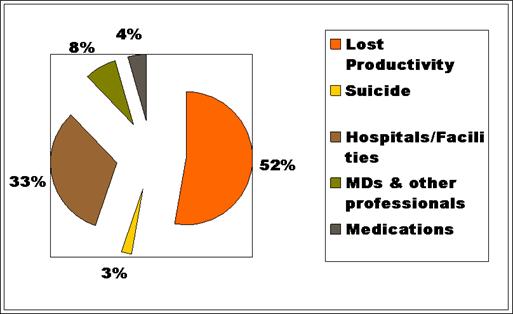Appendices
Appendix IV: Illustration of Emerging Trends
From Statistics Canada Participation and Activity Limitation Survey (PALS) 2001
Total Number and Percentage of People with Disabilities in Canada
- Approximately 3.6 million people in Canada have disabilities, representing 12.4 per cent of Canada’s population
Total Number and Percentage of People with Disabilities in Ontario
- Approximately 1.5 million people in Ontario have disabilities, representing 13.5 per cent of Ontario’s population
Disability Rate Increases with Age
- Of the total Canadian population, 12.4 per cent have a disability. National statistics indicate that 40.5 per cent of people aged 65+ have a disability, while amongst those aged 15-64, 9.9 per cent have a disability. Of the total population of Canadian children aged 0-14, 3.3 per cent have a disability.
Projected statistics on Aging Population
- Population projections estimate that by 2021, Canadians aged 65 and older will number close to 6.7 million or about one-fifth of the total population. The share of seniors in the Canadian population will be one of the highest among the industrialized countries (Statistics Canada Source: Family violence against older adults”, Family violence in Canada: a statistical profile, catalogue number 85-224-XIE, 2002; and “Seniors….The market to watch in the next millennium”, Travel-log, Autumn 1999, Vol. 18, no.4).
**PALS provide information on the prevalence of people with disabilities, their employment profile, their income and their participation in society.
Region of Peel Statistics
The Region of Peel is one of the most rapidly growing communities in the Greater Toronto Area and Hamilton (GTAH) area. The Region is made up of the City of Mississauga which is urban, the City of Brampton which is rapidly urbanizing and the Town of Caledon which is largely rural in character.
Peel Region has experienced significant growth over the past decades and will continue to do so in the future. Between 1991 and 2006, Peel Region experienced an increase in population from approximately 760,000 in 1991 to 1.2 million. Over the next 25 years, it is expected to increase to 1.64 million by 2031. Figure 1 below provides an indication of growth in the Region. It must be noted that major future population growth can be attributed to the City of Brampton. The below population forecasts for 2041 and 2051 are not approved by Council but used for illustration purposes.
Figure 1: Population Forecasts in Peel
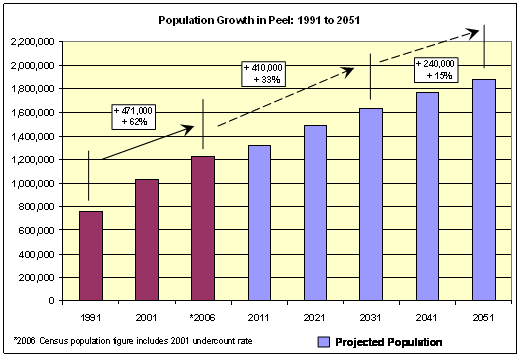
Source: Statistics Canada, 1991, 2001 and 2006 Censuses
and Planning Policy and Research Division Forecasts
Peel has a strong labour force and this will continue into the future. In 2001, the working age groups (15-64) made up 71% of the total population. In 2006 this decreased to 70%. The population of the working age groups is estimated to decrease to 64% in 2031 and to 61% by 2051. These slight decreases can be attributed to an increasingly aging population. Figure 2 below provides an illustration of the working age trend. The below forecasts for 2041 and 2051 are not approved by Council but used for illustration purposes.
Figure 2: Total Population and Working Age in Peel Forecasts
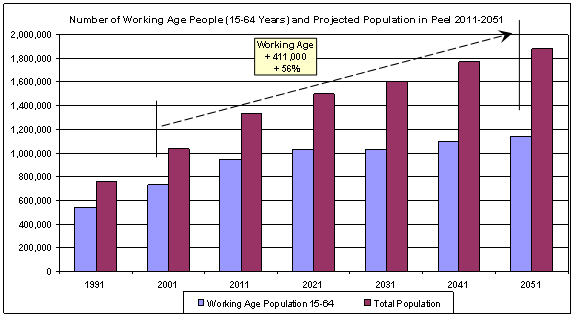
Source: Statistics Canada, 1991 and 2001 Censuses
and Planning Policy and Research Division Forecasts
As per 2006 Census data, the Region has an over 55 (older adult) population making up about 19% of the total population. However, by the year 2031, it is estimated to increase to about 33% and by 2051 it is estimated that 38% of the total population will be older adults. In terms of the over 75 age group, more than 42,000 people were older than 75 years of age in 2006; in 2031 this figure will increase to nearly 140,000. This is more than three times as many people over the age of 75 as today. It is estimated that in 2051, the over 75 years’ age group will be the largest age group in the Region with over 260,000 people. Figure 3 below provides a picture of the number of older adults in Peel between 1991 and 2051. Please note that forecasts for 2041 and 2051 are not approved by Council but used for illustration purposes.
Figure 3: Older Adults in Peel Forecasts
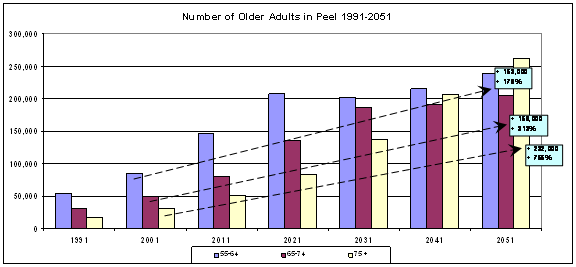
Source: Statistics Canada, 1991 and 2001 Censuses,
and Planning Policy and Research Division Forecasts
Since the incidence of disability increases significantly with age, the above noted trend indicates that the number of persons with disabilities and related needs to access Regional services can be expected to increase at a high rate in the future. It is anticipated that with the aging of the population, the number of persons with disabilities is expected to increase at a higher rate than the total population. The below graph (Figure 4) indicates that the number of persons with disabilities in the Region of Peel is expected to increase by 75% relative to year 2001 using 2001 Census data. Please note the these forecasts are based on a 2004 study and therefore reflects the most current forecasts available at that time.
Figure 4: Forecast Growth in Disabled Population in Peel
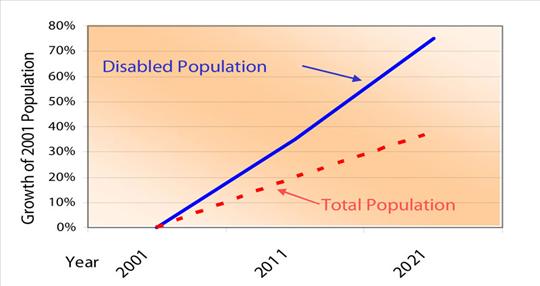
The incidence of disability among the population increases significantly with age. The below graph (Figure 5) shows the percent of the total population in each age cohort with a disability that limits daily living activities using 2001 Census data. Overall, about 12.4% of the total Canadian population has a disability that impacts their everyday activities. As previously noted, these forecasts are based on a 2004 study and therefore reflect the most current forecasts available at that time.
Figure 5: Per Cent of Population with Disabilities by Age Group in Canada
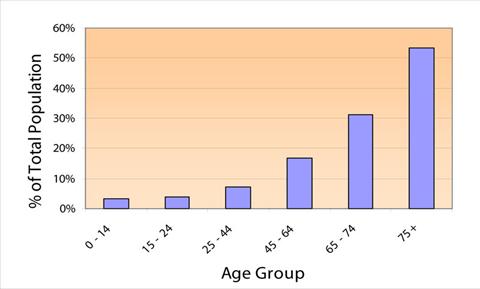
Another key trend is related to mental health in Canada. According to the World Health Organization, five of the 10 leading causes of disability worldwide are mental disorders and substance misuse. It must be noted that only about one-third of affected people see a health professional for mental health issues and only about 21 percent of affected people who felt they needed help actually obtained such help while others did not seek medical help. It is estimated that by 2020, depression will be the second leading cause of disability worldwide. Data from 1995 to 2002 illustrates that in Peel the annual number of hospitalizations for depression are about 400 people. This is an important fact because this figure only captures serious instances of depression, however does not capture those that do not seek help. Figure 6 below illustrates the affects of mental health in Canada.
Figure 6: Impacts of Mental Health in Canada
